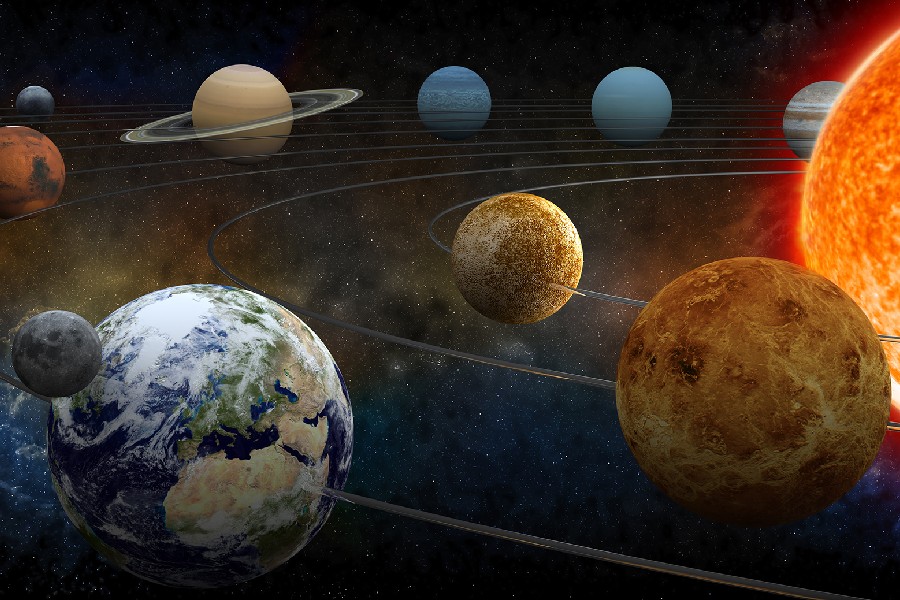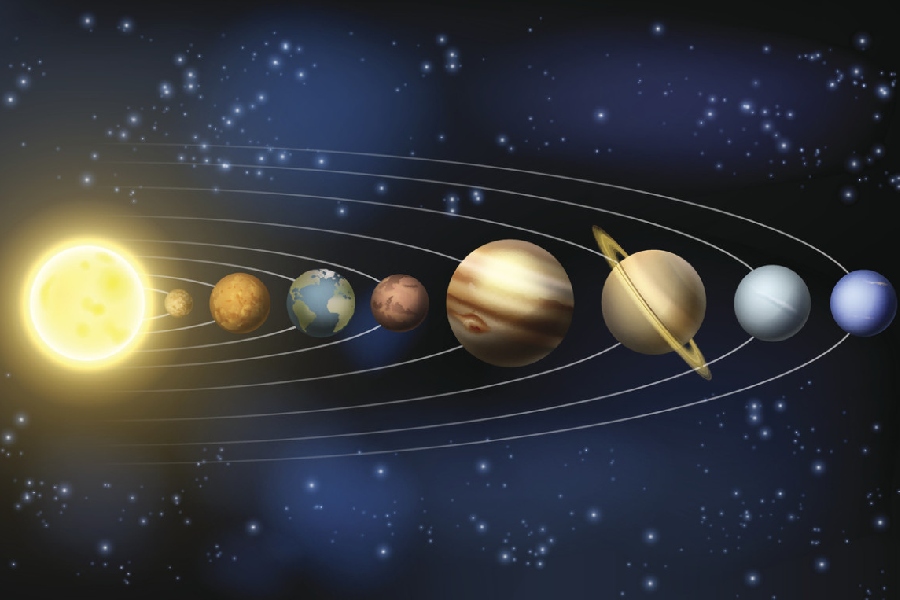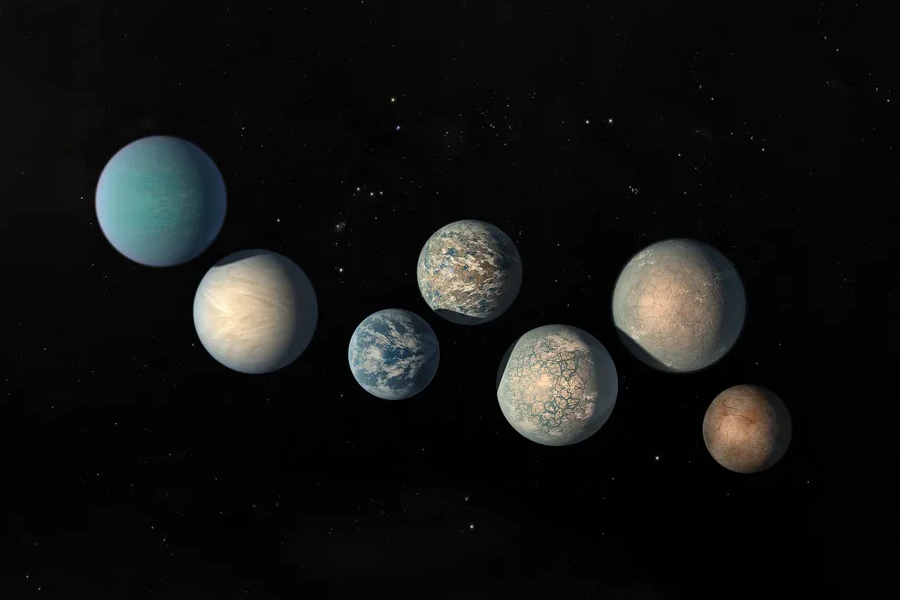In the vast expanse of the cosmos, planets hold a unique allure. These celestial objects, often visible as shining dots in the night sky, have captured human imagination for millennia. But what are planets?
The study of planets is not merely an academic pursuit but a journey into the heart of our cosmic neighborhood. These celestial bodies, both in our solar system and beyond, offer invaluable insights into the mysteries of the universe.
In our quest to understand the universe, we have launched ambitious missions and employed advanced satellites to scrutinize the nature of these enigmatic celestial bodies.
Let’s take a cosmic journey to discover different types of planets, learn how they formed, and explore what makes each of them unique in the vast cosmic puzzle.
What Are Planets?
At its core, a planet is a celestial body that orbits a star, like our Sun but doesn’t shine with its own light. Instead, planets reflect the light of their parent star. This reflected light is what makes them visible to us from Earth.
Furthermore, planets are cosmic wanderers that orbit stars; in our case, the radiant Sun. They come in various forms, from rocky, terrestrial worlds to gas giants with no solid surfaces. To truly appreciate the significance of studying planets, it’s essential to first understand their fascinating diversity and characteristics.
These worlds have unique properties and play a crucial role in our understanding of the universe. In our solar system, the Sun takes center stage, with eight well-known planets circling it.

Understanding planets
The definition of a planet can be quite nuanced, but it typically revolves around a few key criteria. As we said, planets are celestial bodies that orbit stars, but there are exoplanets that orbit other stars in the galaxy.
Furthermore, planets must possess sufficient mass. This means they have enough material for gravity to pull them into a nearly round shape. This is why they are often referred to as “spherical” or “spheroidal” bodies.
Lastly, planets have cleared their orbital path of other debris or celestial bodies. In simpler terms, they’re the dominant gravitational force in their orbital neighborhood.
Categories
Key Planetary Features
Planets, whether in our solar system or beyond, share several common characteristics.
- They all follow an elliptical or nearly circular path around their parent star. The gravitational pull of the star governs this motion.
- Planets typically rotate on their axes, causing day-night cycles and influencing their climates and weather patterns.
- They exhibit a wide range of surface features, from mountains and valleys to plains and oceans. These features result from geological processes and, in some cases, the presence of liquid water.
- Many planets have atmospheres that vary in composition and thickness. These atmospheres can affect temperature, weather, and the potential for life.
Differences Among Planets
While planets share common characteristics, they also exhibit significant differences:
- Size and mass — Planets vary greatly in size and mass. Terrestrial planets like Earth are relatively small and rocky, while gas giants like Jupiter are immense and composed mostly of gas.
- Atmospheric composition — The composition of planetary atmospheres differs widely. Earth’s atmosphere is primarily nitrogen and oxygen, while Venus has a thick, toxic atmosphere of carbon dioxide.
- Surface conditions — Surface conditions can be extreme. Venus, for instance, has a scorching hot surface due to its thick atmosphere, while Mars is frigid and has a thin atmosphere.
- Moons — Some planets have moons, which can significantly influence their gravitational interactions and even contribute to their geological processes.
Types of Planets
When we explore the universe and its countless celestial objects, we encounter a variety of planets, each with its distinct characteristics and composition. Here, we’ll categorize planets into different types to better understand their diversity and uniqueness:
Terrestrial planets
Terrestrial planets, also known as rocky planets, are the innermost planets in our solar system, and they closely resemble Earth in many ways.
Terrestrial planets are solid, compact worlds with hard surfaces. In our solar system, the terrestrial planets include Mercury, Venus, Earth, and Mars.
These planets typically have a rocky or metallic surface, with solid cores at their centers. They tend to have thin atmospheres compared to gas giants, and their surfaces can feature various geological formations like mountains, valleys, and impact craters.
Gas giants
Gas giants are massive planets primarily composed of gases and lack a solid surface. These colossal worlds are found in the outer regions of our solar system.
Gas giants are defined by their immense size and gaseous composition. In our solar system, Jupiter and Saturn are the gas giants.
These planets are predominantly composed of hydrogen and helium, with no solid surface. Their atmospheres are thick and feature complex cloud patterns, powerful storms, and numerous moons and ring systems.
Ice giants
Ice giants are a distinct category of planets that share some similarities with gas giants but differ in significant ways.
Ice giants are characterized by their composition, primarily consisting of heavier volatile substances like water, ammonia, and methane. In our solar system, Uranus and Neptune are classified as ice giants.
These planets have a smaller percentage of hydrogen and helium in their atmospheres compared to gas giants. They are called “ice giants” because of the high concentration of volatile ice in their composition. Despite their name, they don’t have solid surfaces like terrestrial planets.
Dwarf planets
Dwarf planets are celestial bodies that orbit the Sun but don’t meet all the criteria to be considered full-fledged planets.
Dwarf planets are smaller than regular planets and often share their orbital neighborhood with other objects. Notable examples include Pluto, Eris, Haumea, Makemake, and Ceres.
Dwarf planets vary in size and composition, but they are generally smaller and less massive than terrestrial planets or gas giants. They often have irregular shapes and may have moons of their own.
The classification of a celestial body as a dwarf planet depends on its specific characteristics and its gravitational dominance in its orbital region.
Planetary Formation
The birth of planets is a captivating journey that takes place within the universe. Scientists have developed several theories to explain how planets form, and these processes are continually unfolding within and beyond our solar system.
Theories of planetary formation
Accretion theory
This widely accepted theory proposes that planets form from the dust and gas found in protoplanetary disks. It begins with tiny solid particles, called planetesimals, colliding and sticking together.
These planetesimals gradually grow larger, eventually forming planet-sized bodies. The process can take millions of years and results in the creation of terrestrial planets or the solid cores of gas giants.
Core accretion model
This theory specifically explains the formation of gas giants. It suggests that a rocky core forms first, attracting gas from the surrounding disk over time. As the core accumulates more gas, it eventually becomes a massive gas giant like Jupiter or Saturn.
Disk instability model
In contrast to the core accretion model, the disk instability model proposes that gas giants can form directly through the fragmentation of protoplanetary disks. Clumps of gas and dust within the disk collapse under their gravity, forming gas giants relatively quickly.
Role of the solar system in planet formation
Solar nebula hypothesis
The formation of our solar system is thought to have started with the collapse of a massive cloud of gas and dust called a solar nebula. As it collapsed, it began to spin and flatten into a spinning disk. The Sun formed at the center, while the material in the disk gradually came together to create planets, moons, asteroids, and comets.
Differentiation
Within the solar system, we observe a wide variety of planets, each with its unique characteristics. Terrestrial planets like Earth, Mars, Venus, and Mercury are rocky and composed mainly of metals and silicates.
Gas giants like Jupiter and Saturn consist primarily of hydrogen and helium, with no solid surfaces. This differentiation occurred during the early stages of planetary formation, as planets formed from distinct regions within the protoplanetary disk.
Ongoing planetary formation beyond our solar system
Exoplanets
With the advancement of astronomical technology, scientists have discovered thousands of exoplanets — planets orbiting stars beyond our Sun. These discoveries have provided a wealth of information about the diversity of planetary systems and how planets can form in a wide range of environments.
Protoplanetary disks
Ongoing observations using powerful telescopes have revealed protoplanetary disks around young stars, where new planets are in the process of forming. These disks are akin to the birthplaces of planets, where the same fundamental processes that shaped our solar system are at work, albeit in varying conditions.
Diversity of exoplanets
Exoplanet studies have revealed planets with unique characteristics, such as “hot Jupiters” orbiting closely to their stars or “super-Earths” that are larger than Earth but smaller than gas giants. These diverse discoveries challenge our preconceived notions of how planets form and evolve, driving ongoing research in the field of planetary science.

Notable Planets in the Solar System
The solar system is home to many fascinating planets, each with its own unique characteristics, history, and significance. Here are some of the most notable planets that orbit our Sun:
Earth
Earth is the third planet from the Sun and the only known celestial body to support life. It’s often referred to as the “Blue Planet” due to its vast oceans. Earth’s diverse ecosystems, climate, and geological features make it a planet of immense importance for scientific study and human existence.
Jupiter
Jupiter is the largest planet in our solar system, often called a “Gas giant”. It’s characterized by its immense size, with a diameter over 11 times that of Earth. Jupiter’s iconic feature is its Great Red Spot, a massive storm that has been raging for centuries. This planet plays a crucial role in the solar system’s dynamics, influencing the orbits of other nearby celestial bodies.
Mars
Mars, often referred to as the “Red Planet“, is known for its reddish appearance due to iron oxide (rust) on its surface. It has been a focus of scientific exploration due to its potential habitability. Mars missions have revealed intriguing features like the Olympus Mons volcano and Valles Marineris canyon system, sparking interest in future human missions to the planet.
Saturn
Saturn is another gas giant famous for its stunning ring system. These rings consist of countless icy particles and debris, creating one of the most captivating sights in the night sky. Saturn’s unique rings have been a subject of scientific study and artistic inspiration for centuries.
Venus
Venus, often called “Earth’s twin“, is similar in size and composition but has a vastly different climate. It experiences a runaway greenhouse effect, resulting in surface temperatures hot enough to melt lead. Venus missions have provided valuable insights into the challenges of extreme planetary environments.
Uranus
Uranus is a distant ice giant, notable for its unique feature: it rotates on its side, making it appear to roll along its orbital path. This unusual tilt is believed to result from a collision in its early history. Uranus’ atmosphere is primarily composed of hydrogen and helium, with traces of methane that give it a blue-green color.
Mercury
Mercury is the closest planet to the Sun and experiences extreme temperature variations due to its lack of a significant atmosphere to regulate heat. It’s a rocky planet with a heavily cratered surface. Despite its scorching days and freezing nights, Mercury has been explored by spacecraft like MESSENGER, shedding light on its geological history.
Neptune
Neptune is the furthest known planet from the Sun and is classified as an ice giant. It’s characterized by its deep blue color, which is the result of methane in its atmosphere. Neptune’s winds are among the strongest in the solar system, and it has a notable dark storm system called the “Great Dark Spot”.
Exoplanets and the Search for Habitable Worlds
The search for habitable worlds beyond our solar system has opened up a new frontier in astronomy and planetary science. Exoplanets, or planets that orbit stars outside our Sun have become the focus of intense research as scientists seek to answer one of humanity’s most profound questions:
Are we alone in the universe? Let’s discover more about the fascinating world of exoplanets and the search for habitable environments.
Defining exoplanets
Exoplanets, also known as extrasolar planets, are planets that orbit stars other than our Sun. These distant worlds come in various sizes, compositions, and orbits. They can be rocky, like Earth, or gaseous, resembling Jupiter or Neptune. The study of exoplanets has transformed our understanding of planetary systems and their potential for hosting life.

Methods of exoplanet detection
Detecting exoplanets is difficult, considering the vast distances involved and the fact that these planets don’t emit their light. Astronomers have developed ingenious methods to identify and study these distant celestial bodies:
- Transit photometry — This involves monitoring a star’s brightness over time. When an exoplanet passes in front of its host star, it causes a temporary dip in its brightness, known as a transit. By measuring these periodic brightness changes, astronomers can infer the exoplanet’s presence, size, and orbital characteristics.
- Radial velocity (Doppler spectroscopy) — Exoplanets exert gravitational influence on their host stars, causing them to wobble slightly. This wobble can be detected through shifts in the star’s spectral lines. Radial velocity measurements allow astronomers to determine the exoplanet’s mass, orbit, and distance from the star.
- Direct Imaging — Some exoplanets are large and distant enough from their stars to be imaged directly using advanced telescopes. Direct imaging provides information about an exoplanet’s appearance, atmosphere, and potential habitability.
- Microlensing — When a massive object, like an exoplanet, passes in front of a more distant star, it acts as a gravitational lens, magnifying the star’s light. This temporary brightening can be observed and used to detect exoplanets, even those at great distances from Earth.
- Astrometry — This involves measuring the precise positions and motions of stars. Exoplanets cause subtle shifts in their host stars’ positions, allowing astronomers to infer the presence of these planets and estimate their masses.
Promising exoplanetary candidates for habitability
The search for habitable exoplanets, often referred to as “Goldilocks planets”, focuses on finding worlds with conditions suitable for liquid water—a key ingredient for life as we know it. Promising candidates for habitability include:
- Proxima Centauri b — Located in the habitable zone of the closest star to our Sun, Proxima Centauri b offers hope for potential habitability.
- Kepler-442b — This exoplanet orbits a sun-like star in the habitable zone. Its similarity to Earth’s size and temperature makes it an intriguing target for further study.
- TRAPPIST-1 System — This star system hosts seven Earth-sized planets, three within the habitable zone. Their proximity to each other raises the possibility of interactions and exchanges of material, which could impact their habitability.
- TOI 700d — This exoplanet orbits a small, cool star within the habitable zone. It represents another potential haven for life beyond our solar system.
The search for habitable exoplanets continues with technological advancements and the launch of sophisticated space telescopes like the James Webb Space Telescope. These incredible discoveries bring us closer to answering whether life exists elsewhere in the cosmos.
Planetary Exploration
Planetary exploration is a fascinating journey from ancient observations to the cutting-edge missions of today. It all started with the Babylonians and Greeks, who tracked planets like Mercury, Venus, Mars, Jupiter, and Saturn.
The Copernican Revolution introduced the heliocentric model, while telescopes in the 17th century led to discoveries like Jupiter’s moons and Saturn’s rings.
The Space Age began in the mid-20th century with Sputnik 1, followed by missions like Luna 1 and NASA’s Mariner and Viking programs, which unveiled the secrets of Venus, Mars, and more. Voyager 1 and 2 explored the outer planets in the late 20th century.
Today, Mars is under scrutiny with NASA’s Perseverance rover, while the upcoming Mars Sample Return mission aims to bring Martian samples to Earth. Jupiter and Saturn are in focus, with Juno studying Jupiter and the Europa Clipper mission investigating Jupiter’s moon, Europa.
Moreover, BepiColombo is en route to Mercury, and missions like VERITAS and DAVINCI+ will explore Venus. Key discoveries include signs of past water on Mars, Juno’s insights into Jupiter’s atmosphere, Cassini’s revelations about Saturn’s moons, and New Horizons’ flyby of Pluto. The journey continues, promising more revelations about our solar system’s planets.
Conclusion
This article has provided a comprehensive exploration of the planets, shedding light on their remarkable diversity and significance within the cosmos.
From the rocky landscapes of terrestrial planets to the majestic grandeur of gas giants and the enigmatic charm of ice giants and dwarf planets, we’ve discussed celestial bodies in our solar system.
We’ve also delved into the exciting realm of exoplanets, expanding our horizons and kindling the hope of finding habitable worlds beyond our cosmic neighborhood.
As we conclude this cosmic journey, we trust that you’ve found inspiration in the mysteries of the universe and that the wonders of planets have sparked your curiosity. We invite you to continue exploring the cosmos, for there is always more to discover, and the universe beckons with its endless marvels.
